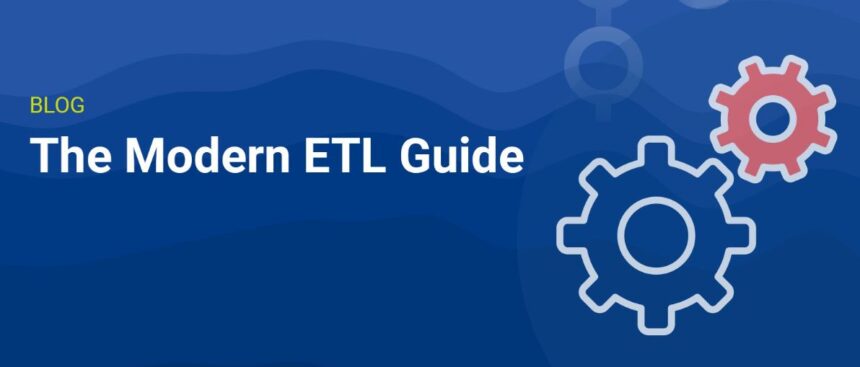Consider a Fortune 500 company processes 20TB of data daily, that includes customer transactions, IoT sensor feeds, and real-time market trends, without a single data engineer writing Spark code.
This isn’t sci-fi. It’s the current no-code ETL reality, where modern tools have transformed clunky, months-long data projects into self-serve, drag-and-drop operations. ETL tools have undergone a massive evolution, empowering businesses to efficiently manage and scale their data without requiring a team of engineers to write complex code.
But not all ETL tools are created equal. The best ones share three superpowers:
- Scale to handle petabytes without breaking a sweat
- Flex to adapt when schemas change overnight
- Zero-code interfaces that business analysts love.
This guide cracks open the black box of modern ETL tools, revealing:
- What separates no-code platforms from legacy tools
- 5 must-have features for enterprise use
- How no-code is eating traditional data engineering.
Let’s dive into what makes modern ETL tools scalable, flexible, and essential for businesses in 2025.
Why ETL Tools Aren’t What They Used to Be?
In the past, ETL tools required hand-coded pipelines using languages like Python or SQL. Building these pipelines took months, and organizations spent significant resources just to keep them running. Additionally, the schemas in those systems were rigid, breaking whenever source data structures changed.
- Time-Consuming Development: Custom code-based ETL tools often required 6+ months to build and deploy.
- High Maintenance: These systems demanded ongoing development to maintain, with a significant cost to the business.
- Costly Operations: Companies spent up to $250K annually just to keep their traditional ETL tools operational.
Here’s a real-word example:
According to LinkedIn, a company building a platform helped manage employee benefits and secured $350k in funding. This highlights the potential for innovative solutions to address existing challenges and reduce costs.
2025’s Game-Changing Shifts
In 2025, we see ETL tools adapting to the new world of scalable, flexible, and user-friendly data integration.
Here are some key shifts:
| Change | Impact | Tools |
| No-code interfaces | Business analysts build pipelines with ease | Hevo Data |
| Auto-scaling infrastructure | No more over-provisioned clusters, pay as you go | Fivetran |
| Embedded AI | Auto-detect schema drift and adjust automatically | Talend |
Next, we’ll explore what makes a good ETL tool.
5 Pillars of Modern ETL Tools You Must Know
Not all ETL tools are created equal. To help you choose the right tool for your organization, there are several key features and capabilities to look for:
-
True No-Code = True Democratization
Gone are the days when “no-code” meant basic CSV imports. Modern ETL tools with true no-code functionality empower business users to manage data workflows without relying on IT.
These tools feature:
- Visual workflow builders (drag-and-drop transformations)
- Natural language queries like “Show me failed transactions last hour”
- Auto-generated documentation for transparency and ease of use.
Pro Tip: The best ETL tools for data integration let you preview transformations before deployment, reducing errors and improving efficiency.
-
Elastic Scalability
Modern ETL tools are built to scale with your business, no matter how large the data set becomes.
Key characteristics of scalable tools include:
- Spin up/down compute resources in seconds (not hours)
- Compress data 3-5x before transfer, reducing bandwidth costs
- Parallelize workloads across thousands of cores to process massive datasets.
This elasticity ensures your ETL tool can handle petabytes of data without breaking a sweat, growing as your data needs expand.
-
Schema Intelligence
One of the challenges of data integration is schema drift—when source data structures change unexpectedly. Modern ETL tools can handle these shifts without disruption. Features to look for:
- Instant schema detection when changes occur
- Mapping of new schemas to downstream tables automatically
- Alerts notifying teams of schema changes with suggested remediation steps.
This proactive approach helps businesses avoid downtime or data inconsistencies due to schema changes.
-
Real-Time + Batch Hybrid Engine
Modern ETL tools can handle a variety of data processing modes, ensuring flexibility for different use cases:
- Streaming: Perfect for fraud detection, real-time analytics, and operational intelligence, offering latency as low as 5 seconds.
- Micro-batches: Ideal for daily reports or dashboards with a latency of about 15 minutes.
- Bulk processing: Best for batch data loads and data warehousing with a 24-hour processing window.
This hybrid approach allows businesses to select the appropriate method based on their specific needs, balancing speed and efficiency.
-
Observability That Doesn’t Sleep
Effective monitoring and error detection are crucial to ensure the health of your data pipelines and prevent any errors from impacting your analytics.
ETL tools with observability features provide:
- Pipeline health scores (0-100) to monitor overall pipeline performance
- Column-level lineage to trace data transformations back to their source
- Anomaly detection that flags issues like drastic drops in sales data, ensuring quick action.
Let’s now take a closer look at some of the top ETL tools for data integration available today.
The 2025 ETL Tool Landscape
While all ETL tools aim to automate the flow of data across systems, each tool brings its own strengths and unique features to the table. Let’s explore some of the best ETL tools available in 2025, offering cloud-native capabilities that cater to diverse business needs.
-
Hevo Data: The Ultimate No-Code ETL Solution
Hevo Data is a standout option for businesses seeking a no-code and scalable ETL solution. It integrates seamlessly with over 150 data sources and cloud data warehouses like Databricks, Snowflake, and Redshift, making it a top choice for organizations.
Why Choose Hevo?
- Real-time replication for timely insights.
- Easy integration with multiple cloud platforms.
- Intuitive, user-friendly interface with no coding required.
-
Fivetran
The automated ETL tool is known for enterprise compliance with 200+ pre-built connectors. It supports fully managed data pipelines with minimal setup, making it ideal for organizations that want to offload the maintenance of their ETL processes.
Why Choose Fivetran?
- Automatic schema migration.
- Effortless connectors for numerous data sources.
- Low maintenance with automatic updates.
-
Airbyte
It’s a great open-source tool for flexible, customizable ETL workflows for data integration. What makes it unique is its ability to rapidly scale and adapt to new data sources and destinations.
Listed are its top-tier features:
- Open-source flexibility with unlimited connectors.
- Focus on scalability and adaptability.
- Ideal for teams looking for cost-effective, customizable solutions.
-
Apache Nifi
Apache Nifi is an open-source ETL tool for automating the movement of data between systems. It offers a powerful drag-and-drop interface for creating and managing data flows, which makes it particularly suitable for businesses that need to handle diverse data integration use cases.
Why Choose Apache Nifi?
- Intuitive user interface for building data flows.
- Highly flexible for diverse integration scenarios.
- Supports both batch processing and real-time streaming.
-
Talend
Talend is a robust open-source ETL tool with powerful data transformation capabilities. The platform is known for:
- Open-source and highly customizable.
- Focus on data quality alongside integration.
- Comprehensive support for complex transformations.
But before selecting the best ETL tool for data integration, it’s important to keep your specific business needs in mind.
Best Tips for Choosing an Ideal ETL Tool
- Know Your Data Requirements: Understand your data volume, velocity, and complexity to determine whether you need real-time or batch processing.
- Evaluate Integration Capabilities: Ensure the ETL tool supports integrations with your existing data sources and destinations.
- Check for Scalability: Choose a tool that can handle your data growth and scale with your business.
- Look for Ease of Use: A no-code ETL tool simplifies data integration, enabling non-technical users to manage pipelines.
- Consider Pricing: Evaluate the pricing model to ensure it fits within your budget, especially as your data needs grow.
With these key tips in mind, it’s time to look ahead and ensure that your ETL tools are set up for long-term success.
Future-Proof Your Data Stack: 3 Pro Moves
If you’re looking to get the most out of your ETL tools, here are a few strategies to help you future-proof your data stack and maximize the value of your integration efforts.
- Start with a Pilot: Begin by testing one high-impact pipeline (e.g., customer orders), measure time saved vs. traditional methods, and refine your approach.
- Demand SLAs: Ensure your ETL tool provider offers at least 99.95% uptime, <1-hour support response, and PCI/DSS compliance.
- Go Multi-Cloud Early: Choose tools that sync across AWS, GCP, and Azure, avoiding lock-in and giving you flexibility to move your data wherever it’s most efficient.
Conclusion
The revolution in ETL tools is already here. No-code solutions have made it possible for business analysts to build and manage their data pipelines in minutes. Teams that previously relied on developers for every pipeline now have the tools to handle data workflows themselves.
Hevo Data stands out as a top choice in this landscape, offering:
- 1-click pipelines to cloud data warehouses like Snowflake and Databricks
- Enterprise-grade reliability for mission-critical data
- Scaling capabilities that outpace legacy vendors.
Ready to leave behind the limitations of traditional ETL tools? Hevo Data’s zero-code solution lets you automate and optimize your data pipelines in under 15 minutes. Start your free trial today and experience the future of data integration, no code required!




